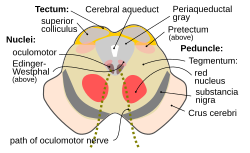
Back أكيمة علوية Arabic Col·licle superior Catalan Colliculi superiores German Άνω διδύμιο Greek Colículo superior Spanish کولیکولوس فوقانی Persian Colliculus supérieur French 上丘 Japanese 위둔덕 Korean Colículo superior Portuguese
| Superior colliculus | |
|---|---|
 Diagram of the superior colliculus (L) of the human midbrain (shown in red) and surrounding regions. The superior colliculus is surrounded by a red ring and transparent red circle to indicate its location. | |
 Section through midbrain at the level of the superior colliculus showing path of oculomotor nerve | |
| Details | |
| Part of | Tectum |
| Identifiers | |
| Latin | colliculus superior |
| MeSH | D013477 |
| NeuroNames | 473 |
| NeuroLex ID | birnlex_1040 |
| TA98 | A14.1.06.015 |
| TA2 | 5912 |
| TH | H3.11.03.3.01002 |
| TE | colliculus_by_E5.14.3.3.1.4.4 E5.14.3.3.1.4.4 |
| FMA | 62403 |
| Anatomical terms of neuroanatomy | |
In neuroanatomy, the superior colliculus (from Latin 'upper hill') is a structure lying on the roof of the mammalian midbrain.[1] In non-mammalian vertebrates, the homologous structure is known as the optic tectum or optic lobe.[1][2][3] The adjective form tectal is commonly used for both structures.
In mammals, the superior colliculus forms a major component of the midbrain. It is a paired structure and together with the paired inferior colliculi forms the corpora quadrigemina. The superior colliculus is a layered structure, with a pattern that is similar to all mammals.[4] The layers can be grouped into the superficial layers (stratum opticum and above) and the deeper remaining layers. Neurons in the superficial layers receive direct input from the retina and respond almost exclusively to visual stimuli. Many neurons in the deeper layers also respond to other modalities, and some respond to stimuli in multiple modalities.[5] The deeper layers also contain a population of motor-related neurons, capable of activating eye movements as well as other responses.[6] In other vertebrates the number of layers in the homologous optic tectum varies.[4]
The general function of the tectal system is to direct behavioral responses toward specific points in body-centered space. Each layer contains a topographic map of the surrounding world in retinotopic coordinates, and activation of neurons at a particular point in the map evokes a response directed toward the corresponding point in space. In primates, the superior colliculus has been studied mainly with respect to its role in directing eye movements. Visual input from the retina, or "command" input from the cerebral cortex, create a "bump" of activity in the tectal map, which, if strong enough, induces a saccadic eye movement. Even in primates, however, the superior colliculus is also involved in generating spatially directed head turns, arm-reaching movements,[7] and shifts in attention that do not involve any overt movements.[8] In other species, the superior colliculus is involved in a wide range of responses, including whole-body turns in walking rats. In mammals, and especially primates, the massive expansion of the cerebral cortex reduces the superior colliculus to a much smaller fraction of the whole brain. It remains nonetheless important in terms of function as the primary integrating center for eye movements.
In non-mammalian species the optic tectum is involved in many responses including swimming in fish, flying in birds, tongue-strikes toward prey in frogs, and fang-strikes in snakes. In some species, including fish and birds, the optic tectum, also known as the optic lobe, is one of the largest components of the brain.
Note on terminology: This article follows terminology established in the literature, using the term "superior colliculus" when discussing mammals and "optic tectum" when discussing either specific non-mammalian species or vertebrates in general.
- ^ a b Squire, L (2013). Fundamental neuroscience (Fourth ed.). Academic Press. p. 707. ISBN 9780123858702.
- ^ Knudsen, EI (June 2011). "Control from below: the role of a midbrain network in spatial attention". The European Journal of Neuroscience. 33 (11): 1961–72. doi:10.1111/j.1460-9568.2011.07696.x. PMC 3111946. PMID 21645092.
- ^ Liu, Tsung-Han; Chiao, Chuan-Chin (25 January 2017). "Mosaic Organization of Body Pattern Control in the Optic Lobe of Squids". Journal of Neuroscience. 37 (4): 768–780. doi:10.1523/JNEUROSCI.0768-16.2016. PMC 6597019. PMID 28123014.
- ^ a b Basso, MA; May, PJ (15 September 2017). "Circuits for Action and Cognition: A View from the Superior Colliculus". Annual Review of Vision Science. 3: 197–226. doi:10.1146/annurev-vision-102016-061234. PMC 5752317. PMID 28617660.
- ^ Wallace et al., 1998
- ^ Gandhi et al., 2011
- ^ Lunenburger et al., 2001
- ^ Cite error: The named reference
Kustovwas invoked but never defined (see the help page).
© MMXXIII Rich X Search. We shall prevail. All rights reserved. Rich X Search